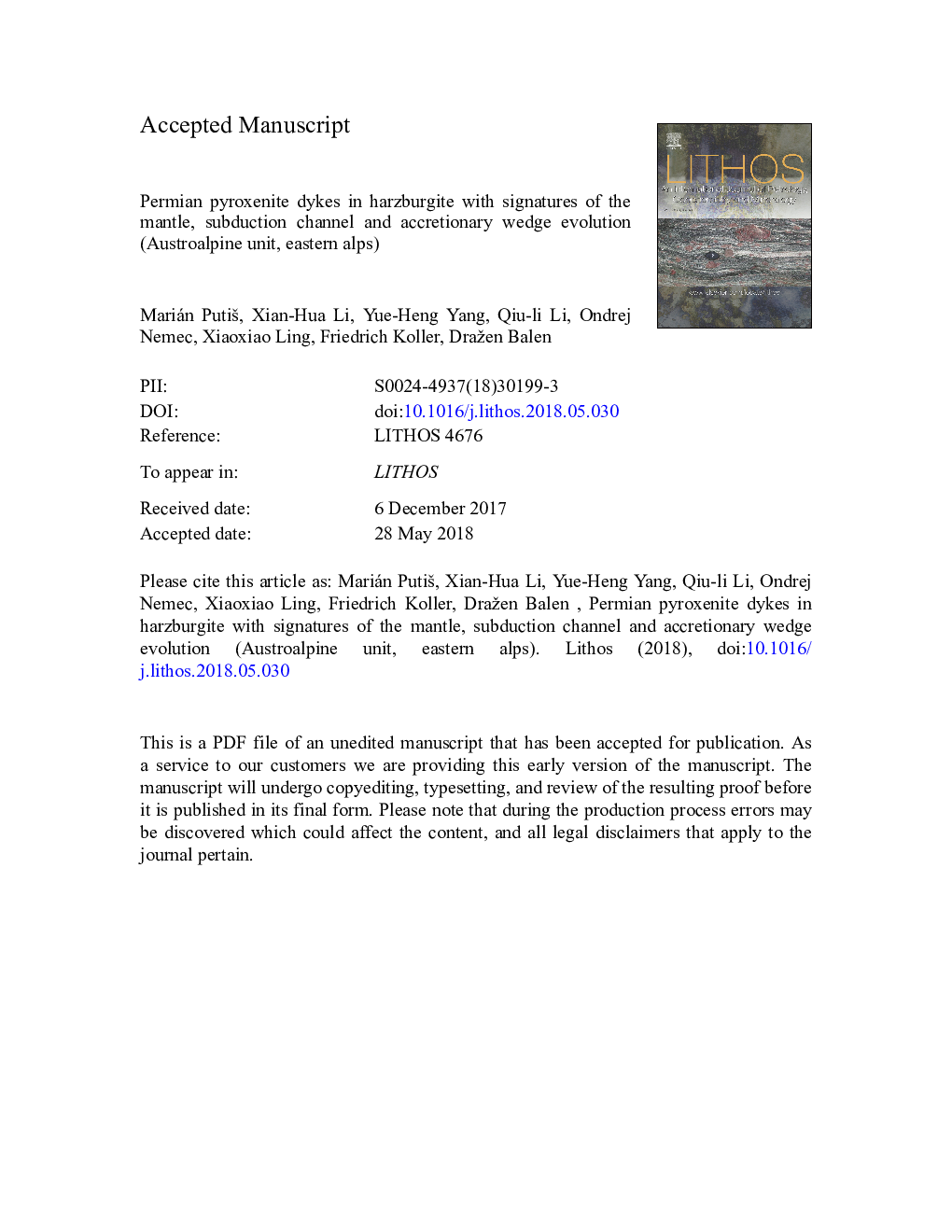| کد مقاله | کد نشریه | سال انتشار | مقاله انگلیسی | نسخه تمام متن |
|---|---|---|---|---|
| 8911546 | 1638617 | 2018 | 71 صفحه PDF | دانلود رایگان |
عنوان انگلیسی مقاله ISI
Permian pyroxenite dykes in harzburgite with signatures of the mantle, subduction channel and accretionary wedge evolution (Austroalpine Unit, Eastern Alps)
دانلود مقاله + سفارش ترجمه
دانلود مقاله ISI انگلیسی
رایگان برای ایرانیان
کلمات کلیدی
موضوعات مرتبط
مهندسی و علوم پایه
علوم زمین و سیارات
ژئوشیمی و پترولوژی
پیش نمایش صفحه اول مقاله

چکیده انگلیسی
Websterite and garnet orthopyroxenite and clinopyroxenite dykes crosscutting harzburgite occur in the hanging wall of a Cretaceous eclogitized continental fragment of the Upper Austroalpine Unit in the Eastern Alps. The dyke textures reflect pressure-temperature changes from the mantle, subduction channel and an accretionary wedge. A clinopyroxenite dyke, dated at 252â¯Â±â¯2â¯Ma on zircon by UPb SIMS, provided εHf(t) zircon values of 16-8 (av. 11 from 18 spots) suggesting a depleted mantle source. The rock modal mineral composition and the mineral and whole-rock chemistry revealed that the pyroxenite dykes' petrogenesis is most likely related to sub-crustal cumulate-type melt derivates, less evolved for websterites and highly evolved for clino- and orthopyroxenites. The porphyroclastic clinopyroxene1 (10-13â¯mol% Ca-Ts), orthopyroxene1, spinel1 and amphibole1 are inferred remnants after magmatic phases. They contain Ti-spinel and ilmenite exsolutions which indicate cooling of the dykes in harzburgite in a Spl stability field (D0-1 stage). Garnet exsolutions in Cpx1, Opx1 and Amp1, and Cpx exsolutions in Amp1 document continuous cooling and/or pressure increase (D0-2 stage). The Grt coronas around Spl1, Opx1, Cpx1 and Amp1, and the granoblastic matrix of Prp-Grs-rich Grt (or Cr-Spl in websterites), low-Al Cpx, low-Al Opx, Fe-enriched olivine, zoisite, kyanite, rutile and pargasite record a subduction channel compression (D1 stage). While the formation of Cpx-Grt or Amp-Grt symplectites replacing the Cpx1 and Amp1 rims suggests the HP-HT decompression (D2-1 exhumation stage). The Grt (or Cr-Spl) replacement by Spl, and Opx1, Cpx1 and Prg replacement by Ol-Spl, Opx-Spl or Prg-Spl symplectites document continuous HT decompression (D2-2 exhumation stage). The MP/MT-LT conditions were estimated from tremolite, Grs-rich Grt, Sr-epidote, clinozoisite, Cl-apatite, titanite, Ce-allanite, chlorite, serpentine and talc assemblage (D3 stage). Anticlockwise P-T path was reconstructed for the D0 to D1 stages followed by almost isothermal exhumation (D2) and emplacement in the Cretaceous accretionary wedge (D3). The pseudosection P-T calculation from a clinopyroxenite dyke yielded 850-825â¯Â°C and 25-28â¯kbar (D1). The whole-rock and mineral trace element data of relic Cpx1 and Amp1, Grt(1-3), Ep-Zo, and younger zircon ages due to Pb-loss, reflect the impact of metamorphic fluids during the D1 to D3 evolutionary stages.
ناشر
Database: Elsevier - ScienceDirect (ساینس دایرکت)
Journal: Lithos - Volumes 314â315, August 2018, Pages 165-186
Journal: Lithos - Volumes 314â315, August 2018, Pages 165-186
نویسندگان
Marián PutiÅ¡, Xian-Hua Li, Yue-Heng Yang, Qiu-li Li, Ondrej Nemec, Xiaoxiao Ling, Friedrich Koller, Dražen Balen,